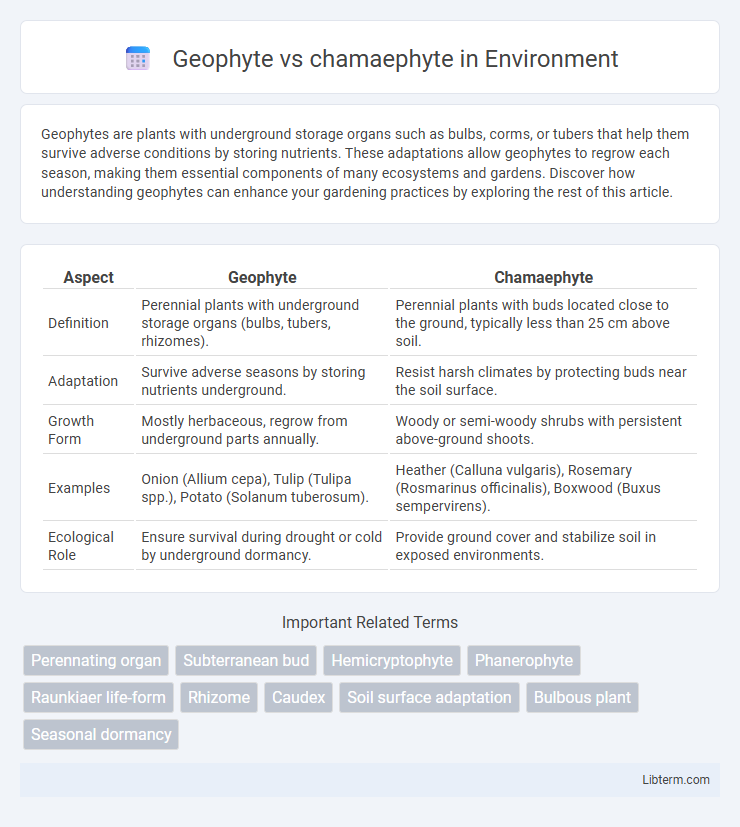Geophytes are plants with underground storage organs such as bulbs, corms, or tubers that help them survive adverse conditions by storing nutrients. These adaptations allow geophytes to regrow each season, making them essential components of many ecosystems and gardens. Discover how understanding geophytes can enhance your gardening practices by exploring the rest of this article.
Table of Comparison
| Aspect | Geophyte | Chamaephyte |
|---|---|---|
| Definition | Perennial plants with underground storage organs (bulbs, tubers, rhizomes). | Perennial plants with buds located close to the ground, typically less than 25 cm above soil. |
| Adaptation | Survive adverse seasons by storing nutrients underground. | Resist harsh climates by protecting buds near the soil surface. |
| Growth Form | Mostly herbaceous, regrow from underground parts annually. | Woody or semi-woody shrubs with persistent above-ground shoots. |
| Examples | Onion (Allium cepa), Tulip (Tulipa spp.), Potato (Solanum tuberosum). | Heather (Calluna vulgaris), Rosemary (Rosmarinus officinalis), Boxwood (Buxus sempervirens). |
| Ecological Role | Ensure survival during drought or cold by underground dormancy. | Provide ground cover and stabilize soil in exposed environments. |
Introduction to Plant Life Forms
Geophytes are perennial plants that survive unfavorable seasons through underground storage organs such as bulbs, tubers, or rhizomes, enabling regrowth when conditions improve. Chamaephytes are small shrubs or perennial herbs with buds located close to the soil surface, typically no more than 25 cm above ground, providing protection from environmental stressors. Both life forms represent adaptive strategies in plant ecology, enhancing survival through different morphological and physiological mechanisms in varying habitats.
Defining Geophytes: Key Characteristics
Geophytes are perennial plants with underground storage organs such as bulbs, tubers, or rhizomes that enable survival during unfavorable seasons. These adaptive structures store nutrients and water, facilitating regrowth after dormancy. In contrast to chamaephytes, which maintain above-ground perennial buds close to the soil surface, geophytes rely primarily on subterranean parts for regeneration and resilience.
Understanding Chamaephytes: What Sets Them Apart
Chamaephytes are perennial plants with buds located close to the ground, typically within 25 cm above the soil surface, enabling them to survive harsh environmental conditions such as frost and grazing. Unlike geophytes, which store energy in underground bulbs or tubers, chamaephytes rely on above-ground woody stems that remain protected during adverse seasons. This unique adaptation allows chamaephytes to thrive in alpine, arid, and cold habitats where ground-level protection is crucial for regeneration and survival.
Morphological Differences Between Geophytes and Chamaephytes
Geophytes possess underground storage organs such as bulbs, tubers, or rhizomes that enable survival through adverse seasons by storing nutrients below the soil surface. In contrast, chamaephytes feature persistent, woody or semi-woody stems that remain close to the ground, typically less than 25 cm above soil level, allowing them to survive harsh conditions above ground. These morphological adaptations distinguish geophytes' subterranean survival strategy from chamaephytes' low-growing, above-ground resilience.
Adaptations to Environmental Conditions
Geophytes survive unfavorable environmental conditions through underground storage organs like bulbs, tubers, or rhizomes, allowing them to regrow after periods of dormancy caused by drought or cold. Chamaephytes adapt by maintaining perennial above-ground shoots close to the soil surface, which reduces exposure to wind and cold, enhancing their survival in harsh climates. Both strategies optimize resource conservation and resilience but target different environmental stressors through distinct morphological adaptations.
Examples of Common Geophytes
Common geophytes include tulips, daffodils, and onions, which survive adverse seasons through underground storage organs such as bulbs, corms, or tubers. These plants store nutrients below the soil surface, allowing them to regenerate and bloom annually despite harsh environmental conditions. Unlike chamaephytes that bear buds close to the ground, geophytes rely on subterranean structures for resilience and regrowth.
Examples of Notable Chamaephytes
Notable chamaephytes include species such as lavender (Lavandula), rosemary (Rosmarinus officinalis), and heather (Calluna vulgaris), which survive harsh environmental conditions by maintaining buds close to the ground. These low-growing woody plants adapt to cold climates by protecting their perennial buds under insulating vegetation or soil layers. Their resilience contrasts with geophytes, which rely on underground storage organs like bulbs or tubers to survive seasonal changes.
Ecological Roles and Significance
Geophytes store nutrients in underground organs, enabling survival through adverse seasons and contributing to soil stabilization and regeneration in ecosystems. Chamaephytes possess perennial buds close to the ground, allowing resilience to grazing and climatic stress, crucial for maintaining vegetation cover in harsh environments. Both growth forms enhance biodiversity and support habitat heterogeneity by adapting to different ecological niches.
Geophyte vs Chamaephyte: Comparative Summary
Geophytes are perennial plants with underground storage organs such as bulbs, tubers, or rhizomes that enable survival during adverse seasons, while chamaephytes are small shrubs or woody plants with buds located close to the ground, typically within 25 cm of the soil surface, providing protection against harsh environmental conditions. Geophytes primarily thrive in seasonal climates with a dormant underground phase, whereas chamaephytes are commonly found in cold or arid environments where their low stature minimizes exposure to wind and frost. The key distinction lies in the location of perennating buds: geophytes rely on subterranean structures, whereas chamaephytes maintain aerial buds close to the ground for overwintering or drought resistance.
Applications in Horticulture and Conservation
Geophytes, with their underground storage organs like bulbs and tubers, are widely used in horticulture for seasonal flowering and drought resilience, making them ideal for garden designs requiring low water input and aesthetic appeal. Chamaephytes, characterized by their small woody stems close to the ground, are vital in conservation for soil stabilization and habitat restoration in harsh climates, supporting biodiversity and preventing erosion. Both plant types contribute to sustainable landscaping by enhancing ecological balance and reducing maintenance needs in various environmental conditions.
Geophyte Infographic

 libterm.com
libterm.com